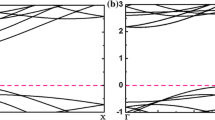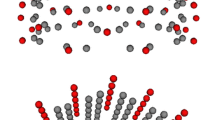Abstract
We investigated the properties of atomic oxygen-doped (O-doped) models of representative (6,0) and (4,4) silicon carbide nanotubes (SiCNTs) by density functional theory (DFT) calculations of isotropic and anisotropic chemical shielding (CS) parameters of Si-29, O-17 and C-13 atoms for the optimized structures. The calculated parameters indicated the effects of O-doping on the electronic environments of the first neighboring atoms of the doped sites. Comparing the results of the zigzag and armchair models also indicated that the latter model detects more effects of the O-doping than the former one.


Similar content being viewed by others
References
Iijima S (1991) Nature 354:56–58
Mykhailenko O, Matsui D, Prylutskyy Y, Le Normand F, Eklund P, Scharff P (2007) J Mol Model 13:283–287
Lal B (2007) J Mol Model 13:531–536
Blasé X, Rubio A, Louie SG, Cohen ML (1994) Europhys Lett 28:335–340
Miyamoto Y, Yu BD (2002) Appl Phys Lett 80:586–588
Chopra NG, Luyken RJ, Cherrey K, Crespi VH, Cohen ML, Louie SG, Zettl A (1995) Science 269:966–967
Sun XH, Li CP, Wong WK, Wong NB, Lee CS, Lee ST, Teo BK (2002) J Am Chem Soc 124:14464–14471
Peralta-Inga Z, Lane P, Murray JS, Boyd S, Grice ME, O’Connor CJ, Politzer P (2003) Nano Lett 3:21–28
Zhao M, Xia Y, Li F, Zhang RQ, Lee ST (2005) Phys Rev B 71:085312
Gali A (18) Phys Rev B 73:245415
Zhang SL (2001) Phys Lett A 285:207–211
Zhang JM, Chen LY, Wang SF, Xu KW (2010) Eur Phys J B. doi:10.1140/epjb/e2010-00020-y
Menon M, Richter E, Mavrandonakis A, Froudakis G, Andriotis AN (2004) Phys Rev B 36:115322
Taguchi T, Igawa N, Yamamoto H, Jitsukawa S (2005) J Am Ceram Soc 88:459–461
Baumeier B, Krüger P, Pollmann J (2007) Phys Rev B 76:085407
Moradian R, Nehzad S, Chegel R (2008) Physica B 403:3623–3626
Moradian R, Nehzad S, Chegel R (2008) J Phys Condens Matter 20:465214
Gao G, Park SH (2009) kang HS. Chem Phys 355:50–54
Cao F, Xu X, Ren W, Zhao C (2010) J Phys Chem C 114:970–976
Szabó Á, Gali A (2009) Phys Rev B 80:075425
Bovey FA (1988) Nuclear Magnetic Resonance Spectroscopy. Academic, San Diego
Frisch MJ, Trucks GW, Schlegel HB, Scuseria GE, Robb MA, Cheeseman JR, Zakrzewski VG, Montgomery JA Jr, Stratmann RE, Burant JC, Dapprich S, Millam JM, Daniels AD, Kudin KN, Strain MC, Farkas O, Tomasi J, Barone V, Cossi M, Cammi R, Mennucci B, Pomelli C, Adamo C, Clifford S, Ochterski J, Petersson GA, Ayala PY, Cui Q, Morokuma K, Malick DK, Rabuck AD, Raghavachari K, Foresman JB, Cioslowski J, Ortiz JV, Baboul AG, Stefanov BB, Liu G, Liashenko A, Piskorz P, Komaromi I, Gomperts R, Martin RL, Fox DJ, Keith T, Al-Laham MA, Peng CY, Nanayakkara A, Gonzalez C, Challacombe M, Gill PMW, Johnson B, Chen W, Wong MW, Andres JL, Gonzalez C, Head-Gordon M, Replogle ES, Pople JA (1998) GAUSSIAN 98. Gaussian Inc, Pittsburgh
Wolinski K, Hinton JF, Pulay P (1990) J Am Chem Soc 112:8251–8260
Mirzaei M, Nouri A (2010) J Mol Struct Theochem 942:83–87
Mirzaei M (2010) J Mol Model. doi:10.1007/s00894-010-0702-z
Author information
Authors and Affiliations
Corresponding author
Rights and permissions
About this article
Cite this article
Mirzaei, M., Mirzaei, M. A computational study of atomic oxygen-doped silicon carbide nanotubes. J Mol Model 17, 527–531 (2011). https://doi.org/10.1007/s00894-010-0751-3
Received:
Accepted:
Published:
Issue Date:
DOI: https://doi.org/10.1007/s00894-010-0751-3




